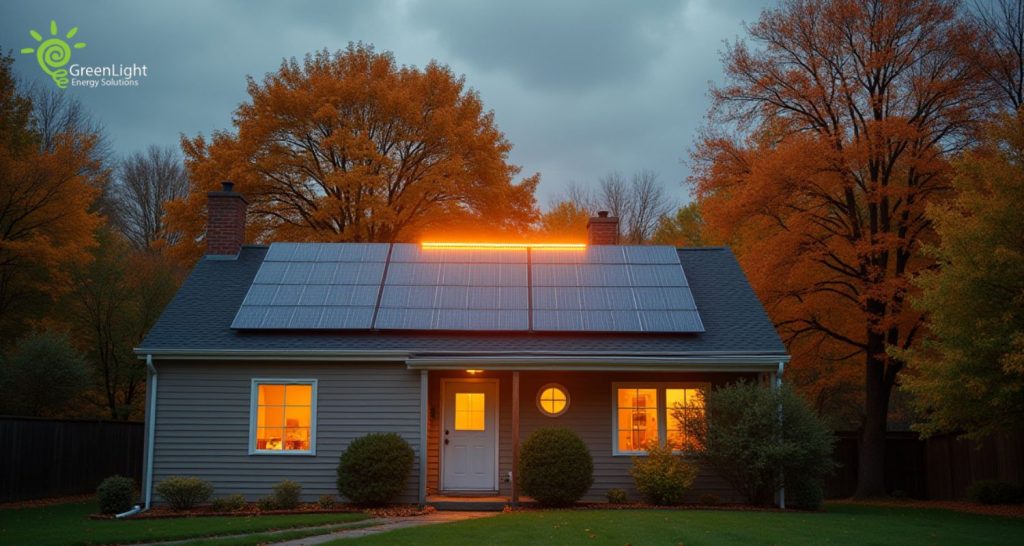Thanks to its abundant sunshine, Australia is one of the world’s leading countries for solar energy adoption. But what happens when the skies turn grey? Do solar panels work in cloudy weather? The short answer is yes, but with reduced efficiency.
Solar panels rely on sunlight to generate electricity, but they don’t require direct sunlight to function. Even in cloudy conditions, they can still produce between 10% and 25% of their standard output, depending on the thickness of the cloud cover. This means homeowners in Melbourne, Hobart, and Sydney—where overcast days are standard—can still benefit from solar power.
However, to get the most out of a solar system in regions with frequent cloud cover, it’s essential to understand how weather conditions impact energy production and what strategies can improve efficiency.
How Do Solar Panels Work on Cloudy Days?
Solar panels use photovoltaic (PV) cells to convert sunlight into electricity. While direct sunlight provides the highest output, PV cells can still capture diffused and reflected sunlight on cloudy days.
The efficiency drop depends on cloud thickness:
- Light cloud cover (e.g., Sydney in autumn): Solar panels may still generate 50-70% of their normal output.
- Moderate cloud cover (e.g., Melbourne in winter): Expect 20-40% efficiency.
- Under heavy overcast conditions (e.g., Hobart during winter), Power generation can drop by 20%.
Interestingly, on some cloudy days, the edge-of-cloud effect can temporarily spike energy production when sunlight reflects off the edges of clouds, enhancing solar panel performance for short periods.
Will solar panels generate electricity during cloudy or rainy days?
Yes, solar panels still generate electricity on cloudy and rainy days, though at a lower output of about 10-25%. Light still penetrates clouds, allowing panels to capture diffused sunlight. Rain can actually benefit the panels by cleaning them, which improves efficiency once the weather clears.
How Rain Affects Solar Panel Performance?
While rain temporarily reduces solar panel output, it plays a crucial role in maintenance. In dry regions like Perth and Adelaide, dust and dirt accumulate on panels, blocking sunlight and lowering efficiency. Rain helps wash away this debris, ensuring panels absorb the maximum sunlight when clear weather returns.
What happens to solar panels on a cloudy day?
On a cloudy day, solar panels operate at a lower efficiency, generating between 10% and 25% of their full potential. However, they continue to produce electricity by capturing diffused light, ensuring that homes and businesses still receive power.
Solar Panel Performance in Low-Light Conditions
Cloudy and rainy weather, early mornings, late evenings, and foggy days also impact solar energy production. However, modern high-efficiency solar panels can capture indirect sunlight, ensuring they generate power in challenging conditions.
Will solar panels work in low light?
Yes, solar panels work in low-light conditions, though with reduced efficiency. Panels can still generate power even during foggy mornings in Melbourne or winter evenings in Canberra. This makes solar battery storage a valuable addition for homes in areas with frequent low-light conditions.
Do solar panels work at night?
No, solar panels do not work at night as they require sunlight to generate electricity. However, solar batteries, such as Tesla Powerwall and LG Chem, store excess energy from the day for use at night.
How Australia’s Climate Affects Solar Panel Efficiency?
Australia experiences various weather conditions, from hot and sunny in the north to cool and cloudy in the south. Here’s how solar panels perform across different Australian climates:
1. Hot and Sunny Climates (Perth, Darwin, Brisbane)
- High solar power generation due to intense sunlight.
- Extreme heat can slightly reduce efficiency, so proper ventilation is needed to prevent overheating.
2. Cloudy and Rainy Climates (Melbourne, Hobart, Sydney)
- Cloud cover reduces energy output, but solar panels still produce 10-25% of their usual capacity.
- Monocrystalline panels (which perform better in low light) can help maximise efficiency.
3. Coastal and Tropical Areas (Cairns, Gold Coast)
- Seasonal storms and humidity can impact performance.
- Elevated mounting helps prevent water damage and ensures better sun exposure.
How to Maximise Solar Energy Production in Cloudy Climates?
If you live in a cloudy or rainy part of Australia, here are some strategies to improve solar panel efficiency:
1. Choose High-Efficiency Panels
- Monocrystalline panels perform better in low-light conditions than polycrystalline panels.
- Bifacial panels capture sunlight from both sides, enhancing energy output.
2. Install a Solar Battery System
- Batteries store excess energy on sunny days for use during cloudy periods or at night.
- Popular battery brands in Australia include Tesla Powerwall, LG Chem, and Sonnen.
3. Keep Panels Clean
- Dirt and bird droppings can block sunlight and reduce efficiency.
- Regular cleaning ensures optimal solar energy absorption.
4. Optimise Panel Placement
- In Australia, north-facing panels generate the most power.
- In some cases, east-west placement can help capture sunlight throughout the day.
5. Consider a Grid-Tied System
- A grid-connected system allows you to use power from the electricity grid when solar generation is low.
Final Thoughts: Is Solar Power Worth It in Cloudy Australian Cities?
Absolutely! Even in Australia’s cloudier cities like Melbourne and Hobart, solar power remains an efficient and cost-effective option.
Modern solar panels are designed to capture both direct and diffused sunlight, ensuring power generation even in overcast conditions. With government rebates, feed-in tariffs, and battery storage solutions, homeowners across Australia can maximise their solar energy investment, reduce electricity bills, and contribute to a more sustainable future.







